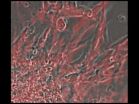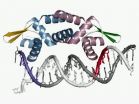(Press-News.org) New research has helped unpick a long-standing mystery about how dietary fibre supresses appetite.
In a study led by Imperial College London and the Medical Research Council (MRC), an international team of researchers identified an anti-appetite molecule called acetate that is naturally released when we digest fibre in the gut. Once released, the acetate is transported to the brain where it produces a signal to tell us to stop eating.
The research, published in Nature Communications, confirms the natural benefits of increasing the amount of fibre in our diets to control over-eating and could also help develop methods to reduce appetite. The study found that acetate reduces appetite when directly applied into the bloodstream, the colon or the brain.
Dietary fibre is found in most plants and vegetables but tends to be at low levels in processed food. When fibre is digested by bacteria in our colon, it ferments and releases large amounts of acetate as a waste product. The study tracked the pathway of acetate from the colon to the brain and identified some of the mechanisms that enable it to influence appetite.
"The average diet in Europe today contains about 15 g of fibre per day," said lead author of the study Professor Gary Frost, from the Department of Medicine at Imperial College London. "In stone-age times we ate about 100g per day but now we favour low-fibre ready-made meals over vegetables, pulses and other sources of fibre. Unfortunately our digestive system has not yet evolved to deal with this modern diet and this mismatch contributes to the current obesity epidemic. Our research has shown that the release of acetate is central to how fibre supresses our appetite and this could help scientists to tackle overeating."
The study analysed the effects of a form of dietary fibre called inulin which comes from chicory and sugar beets and is also added to cereal bars. Using a mouse model, researchers demonstrated that mice fed on a high fat diet with added inulin ate less and gained less weight than mice fed on a high fat diet with no inulin. Further analysis showed that the mice fed on a diet containing inulin had a high level of acetate in their guts.
Using positron emission tomography (PET) scans, the researchers tracked the acetate through the body from the colon to the liver and the heart and showed that it eventually ended up in the hypothalamus region of the brain, which controls hunger.
In collaboration with Consejo Superior de Investigaciones Científicas (CSIC) in Madrid, the researchers investigated the effects of acetate in the hypothalamus using a cutting-edge scanning technique called High Resolution Magic Angle Spinning (HR-MAS). "This complements the PET scans and allows us to follow the metabolism of acetate in the hypothalamus," said Professor Sebastian Cerdán from CSIC. "From this we could clearly see that the acetate accumulates in the hypothalamus after fibre has been digested. The acetate then triggers a series of chemical events in the hypothalamus leading to the firing of pro-opiomelanocortin (POMPC) neurons, which are known to supress appetite."
This is the first demonstration that acetate released from dietary fibre can affect the appetite response in the brain. The research also showed that when acetate was injected into the bloodstream, the colon or the brain it reduced the amount of food eaten by mice.
Co-author on the study Professor Jimmy Bell from the MRC Clinical Sciences Centre said: "It's exciting that we have started to really understand what lies behind fibre's natural ability to supress our appetite and identified acetate as essential to the process. In the context of the growing rates of obesity in western countries, the findings of the research could inform potential methods to prevent weight gain."
Professor Gary Frost added: "The major challenge is to develop an approach that will deliver the amount of acetate needed to supress appetite but in a form that is acceptable and safe for humans. Acetate is only active for a short amount of time in the body so if we focussed on a purely acetate-based product we would need to find a way to drip-feed it and mimic its slow release in the gut. Another option is to focus on the fibre and manipulate it so that it produces more acetate than normal and less fibre is needed to have the same effect, providing a more palatable and comfortable option than massively increasing the amount of fibre in our diet. Developing these approaches will be difficult but it's a good challenge to have and we're looking forward to researching possible ways of using acetate to address health issues around weight gain."
Professor David Lomas, Chair of the MRC's Population and Systems Medicine Board, added: "It's becoming increasingly clear that the interaction between the gut and the brain plays a key role in controlling how much food we eat. Being able to influence this relationship, for example using acetate to suppress appetite, may in future lead to new, non-surgical treatments for obesity."
INFORMATION:
The research was funded by the MRC and the Biotechnology and Biological Sciences Research Council.
For more information please contact:
Franca Davenport
Research Media Officer
Imperial College London
Email: f.davenport@imperial.ac.uk
Tel: +44(0)20 7594 2198
Out of hours duty press officer: +44(0)7803 886 248
Notes to editors
1. Reference: G. Frost et al. 'The short-chain fatty acid acetate reduces appetite via a central homeostatic mechanism, Nature Communications (2014), doi: 10.1038/n-comms4611.
2. About Imperial College London
Consistently rated amongst the world's best universities, Imperial College London is a science-based institution with a reputation for excellence in teaching and research that attracts 14,000 students and 6,000 staff of the highest international quality. Innovative research at the College explores the interface between science, medicine, engineering and business, delivering practical solutions that improve quality of life and the environment - underpinned by a dynamic enterprise culture.
Since its foundation in 1907, Imperial's contributions to society have included the discovery of penicillin, the development of holography and the foundations of fibre optics. This commitment to the application of research for the benefit of all continues today, with current focuses including interdisciplinary collaborations to improve global health, tackle climate change, develop sustainable sources of energy and address security challenges.
In 2007, Imperial College London and Imperial College Healthcare NHS Trust formed the UK's first Academic Health Science Centre. This unique partnership aims to improve the quality of life of patients and populations by taking new discoveries and translating them into new therapies as quickly as possible.
3. The Medical Research Council has been at the forefront of scientific discovery to improve human health. Founded in 1913 to tackle tuberculosis, the MRC now invests taxpayers' money in some of the best medical research in the world across every area of health. Twenty-nine MRC-funded researchers have won Nobel prizes in a wide range of disciplines, and MRC scientists have been behind such diverse discoveries as vitamins, the structure of DNA and the link between smoking and cancer, as well as achievements such as pioneering the use of randomised controlled trials, the invention of MRI scanning, and the development of a group of antibodies used in the making of some of the most successful drugs ever developed. Today, MRC-funded scientists tackle some of the greatest health problems facing humanity in the 21st century, from the rising tide of chronic diseases associated with ageing to the threats posed by rapidly mutating micro-organisms. http://www.mrc.ac.uk
4. About BBSRC
The Biotechnology and Biological Sciences Research Council (BBSRC) invests in world-class bioscience research and training on behalf of the UK public. Our aim is to further scientific knowledge, to promote economic growth, wealth and job creation and to improve quality of life in the UK and beyond.
Funded by Government, and with an annual budget of around £467M (2012-2013), we support research and training in universities and strategically funded institutes. BBSRC research and the people we fund are helping society to meet major challenges, including food security, green energy and healthier, longer lives. Our investments underpin important UK economic sectors, such as farming, food, industrial biotechnology and pharmaceuticals.
For more information about BBSRC, our science and our impact see: http://www.bbsrc.ac.uk
For more information about BBSRC strategically funded institutes see: http://www.bbsrc.ac.uk/institutes
Discovery of anti-appetite molecule released by fiber could help tackle obesity
2014-04-30
ELSE PRESS RELEASES FROM THIS DATE:
Mouse study points to potentially powerful tool for treating damaged hearts
2014-04-30
VIDEO:
This shows heart tissue grown in a dish from mouse cardiac progenitor cells (CPCs). The CPCs, and the tissue they built, were engineered to produce a red protein.
Click here for more information.
A type of cell that builds mouse hearts can renew itself, Johns Hopkins researchers report. They say the discovery, which likely applies to such cells in humans as well, may pave the way to using them to repair hearts damaged by disease — or even grow new heart tissue for transplantation. ...
Suomi NPP satellite sees clouds filling Tropical Storm Tapah's eye
2014-04-30
NASA-NOAA's Suomi NPP passed over Tapah and captured a visible image of the storm that gave a hint of weakening as clouds began to fill its eye. On April 30 at 0900 UTC/5 a.m. EDT, Tropical Storm Tapah continued to weaken as wind shear began to increase and the storm moved toward cooler waters in the Northwestern Pacific Ocean.
NASA-NOAA's Suomi NPP satellite passed over Tropical Storm Tapah on April 30 and the VIIRS instrument aboard captured a visible image of the storm as it weakened from a typhoon to a tropical storm. The imagery showed that Tapah's eye was becoming ...
New experimental vaccine produces immune response against MERS virus
2014-04-30
The University of Maryland School of Medicine (UM SOM) and Novavax, Inc. (NASDAQ: NVAX) today announced that an investigational vaccine candidate developed by Novavax against the recently emerged Middle East Respiratory Syndrome Coronavirus (MERS-CoV) blocked infection in laboratory studies. UM SOM and Novavax also reported that a vaccine candidate against Severe Acute Respiratory Syndrome Coronavirus (SARS-CoV) developed by Novavax on a similar platform also inhibited virus infection. Researchers reported these findings in an article published in the April 13, 2014 issue ...
Whey beneficially affects diabetes and cardiovascular disease risk factors in obese adults
2014-04-30
New evidence shores up findings that whey protein, which is found in milk and cheese, could have health benefits for people who are obese and do not yet have diabetes. The study, which appears in ACS' Journal of Proteome Research, examined how different protein sources affect metabolism.
Lars O. Dragsted, Kjeld Hermansen and colleagues point out that obesity continues to be a major public health problem worldwide. In the U.S. alone, about 35 percent of adults and about 17 percent of children are obese, a condition that can lead to a number of health issues, including ...
SDSC resources, expertise used in genomic analysis of 115 year-old woman
2014-04-30
A team of researchers investigating the genome of a healthy supercentenarian since 2011 has found many somatic mutations – permanent changes in cells other than reproductive ones – that arose during the woman's lifetime. Led by Erik Sistermans and Henne Holstege from the VU University Medical Center in Amsterdam, the team recently published its findings in the journal Genome Research as reported by GenomeWeb.
While previous studies have examined mutations that arise in certain disease conditions such as leukemia, Sistermans said that it was not well known how many mutations ...
N-glycan remodeling on glucagon receptor is an effector of nutrient-sensing by HBP
2014-04-30
TORONTO -- A possible therapeutic target for control of blood glucose in the treatment of type 2 diabetes and obesity has been identified by Dr. Anita Johswich and her colleagues. Their findings were published in Journal of Biological Chemistry, online April 17, 2014.
An imbalance in the competing action of insulin and glucagon is widely viewed as a critical factor in onset of type 2 diabetes, a relentlessly increasing health problem. A delicate balance between two hormones controls blood glucose levels day and night. After a meal, blood glucose rises, which stimulates ...
A protein key to the next green revolution sits for its portrait
2014-04-30
If you pull up a soybean or bean plant and shake off the dirt, you might see odd swellings or bumps, like rheumatic finger joints, on its roots. Inside the cool, soil-covered bumps are bacteria that are making nitrogen with the help of an enzyme, something chemical factories can do only with the help of a catalyst and at high temperature and pressure.
The bacteria, typically members of the genus Rhizobia, break the strong triple bond between the nitrogen molecules in the air and repackage the nitrogen atoms in chemical compounds the plant can use. In return, the plant ...
'Charismatic' organisms still dominating genomics research
2014-04-30
Decades after the genomics revolution, half of known eukaryote lineages still remain unstudied at the genomic level--with the field displaying a research bias against 'less popular', but potentially genetically rich, single-cell organisms.
This lack of microbial representation leaves a world of untapped genetic potential undiscovered, according to an exhaustive survey conducted by UBC researchers of on-going genomics projects. The survey results are published in the May issue of Trends in Ecology and Evolution.
"We're still mostly analyzing the same well-known eukaryotic ...
Deep origins to the behavior of Hawaiian volcanoes
2014-04-30
Kīlauea volcano, on the Big Island of Hawai'i, typically has effusive eruptions, wherein magma flows to create ropy pāhoehoe lava, for example. However, Kīlauea less frequently erupts more violently, showering scoria and blocks over much of the surface of the island. To explain the variability in Kīlauea's eruption styles, a team including Bruce Houghton, the Gordon Macdonald Professor of Volcanology in Geology and Geophysics at the University of Hawai'i at Mānoa (UHM) School of Ocean and Earth Science and Technology (SOEST) and colleagues from ...
New tool for Joint Lab to investigate the chemistry of nature
2014-04-30
This news release is available in German. HZB-scientist Emad Aziz, who leads the Joint lab between HZB and Freie Universität Berlin, has developed and installed a new tool to investigate ultrafast dynamics in solutions and at interfaces with the use of ultrashort Laser pulses. Liquid phases are a natural environment for many interesting processes in chemistry and biology, and short light pulses allow insights into electronic and structural dynamics of molecules and molecular complexes. In particular, photoelectron spectroscopy with extreme ultraviolet (XUV) radiation ...




